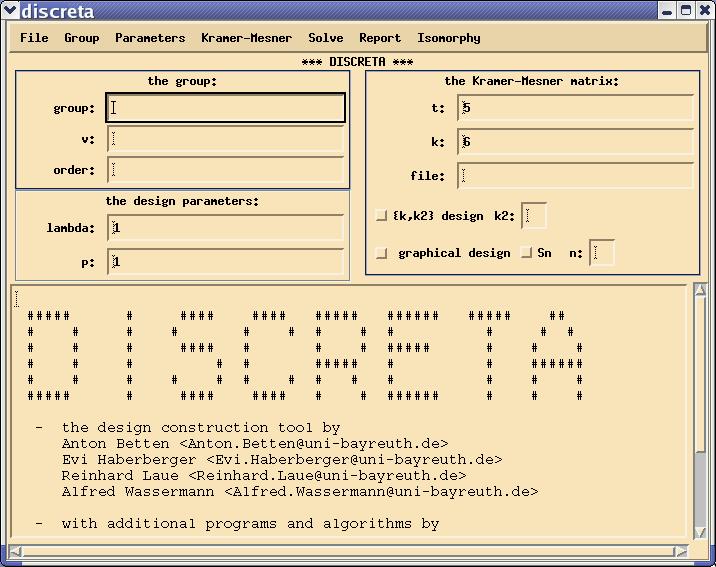
Welcome to DISCRETA. DISCRETA is a program for the construction of incidence structures, t-designs, with prescribed automorphism group. A t-design, or more precisely a t-(v,k,l) design for integers t, v, k and l, is a finite incidence structure, i.e. a finite set of points together with a set of subsets. More precisely, a t-design is a pair (P,B) with P a set of v points, and B a set of k-subsets of P. The set B has the property that whichever t-subset of P is chosen, there are exactly l sets in B containing the chosen set of t points. The sets in B are also called blocks. Hence for any t-subset of points we find exactly l blocks containing them.
The idea to construct such incidence structures is by means of a prescribed automorphism group. An automorphism is just a permutation of the set of points such that when applied to each of the blocks, the set of blocks as a whole is preserved. Here, when we say, we apply a permutation to a block, we mean that we apply the permutation to all point in the block. We then collect all the k points which we get and form a new block of size k out of these (we call this the image of the original block under the given permutation). Of course for a permutation to be an isomorphism, each image block must be contained in B since we required that the set of blocks as a whole stays invariant under that permutation. Now, the set of such automorphisms form a group w.r.t. composition. This means for elements a and b which are automorphisms, the composition ab is again an automorphism. Also, the inverses a-1 are automorphisms. The identity mapping which takes each point to itself is trivially an automorphism. It serves as the identity element in the automorphism group.
Why do we do all this? Well, the construction of t-designs can be a hard task, in particular for certain parameter combinations. t-designs with large t are known to be notoriously hard to construct. At this point, Kramer and Mesner in 1975 introduced their method of constructing designs which are invariant under a group of automorphisms. The clue is that the construction of designs using a prescribed automorphism group becomes much easier the larger the group is. We do not give the details of this construction, but rather go back to DISCRETA and explain how to use this program for this method.
At this point, we see two basic steps in the construction of designs.
As described previously, we have to choose parameters t, v, k and l as well as a permutation group G acting on v points. First of all, we have t < k < v positive integers. In order to be successfull, the design parameret set t-(v,k,l) must satisfy one combinatorial condition. This condition is on l in terms of the other three parameters. More precisely, there are two numbers, Dl and lmax, depending only on t, v and k, and l must be a multiple of Dl but less than lmax. Note that these conditions are only necessary conditions, in other words, we wouldn't find designs if the condition is violated. The conditions are not sufficient for the existence of designs. Note that the condition l not equal lmax just excludes the trivial designs, which consist of all k-subsets of the set of points, which are always t-designs, but at the same time are not very interesting (just because we know they exist for all t < k < v). A design parameter set which satisfies this condition is called admissible.
DISCRETA helps choosing l by computing Dl once t < k < v have been chosen. Let us have a look at the DISCRETA main window:

The discreta_batch calc_lambda_ij 7 33 8 1 calc_lambda_ij t v k lambda calc_delta_lambda(): v=33 t=7 k=8 lambda=1 t'=6 lambda'=27/2 delta_lambda=2 t'=5 lambda'=126/1 delta_lambda=2 t'=4 lambda'=1827/2 delta_lambda=2 t'=3 lambda'=5481/1 delta_lambda=2 t'=2 lambda'=56637/2 delta_lambda=2 t'=1 lambda'=129456/1 delta_lambda=2 t'=0 lambda'=534006/1 delta_lambda=2 warning: this parameter set is not admissible, lambda must be a multiple of 2 !What has happened? Your input amounts to the parameters t-(v,k,1), i.e. with lambda = 1. DISCRETA computes the parameters of the design as an t' design for 0 less or equal t' less than t. The resulting poarameter sets t'-(v,k,lambda') should all be integral, and Delta lambda will be computed as the smallest natural number lambda such that all lambda' are integral. In this case, DISCRETA detects that lambda must be a multiple of Delta lambda, which is 2. Note that if you would have started with an admissible parameter set like 7-(33,8,10), the output would be
calc_lambda_ij t v k lambda
calc_delta_lambda(): v=33 t=7 k=8 lambda=1
t'=6 lambda'=27/2 delta_lambda=2
t'=5 lambda'=126/1 delta_lambda=2
t'=4 lambda'=1827/2 delta_lambda=2
t'=3 lambda'=5481/1 delta_lambda=2
t'=2 lambda'=56637/2 delta_lambda=2
t'=1 lambda'=129456/1 delta_lambda=2
t'=0 lambda'=534006/1 delta_lambda=2
5340060 4045500 3034125 2251125 1650825 1195425 853875 600875
1294560 1011375 783000 600300 455400 341550 253000 0
283185 228375 182700 144900 113850 88550 0 0
54810 45675 37800 31050 25300 0 0 0
9135 7875 6750 5750 0 0 0 0
1260 1125 1000 0 0 0 0 0
135 125 0 0 0 0 0 0
10 0 0 0 0 0 0 0
This time, DISCRETA does not complain, and you find the parameter sets
t'-(v,k,lambda') for 0 less or equal t' less than 7.
Also, DISCRETA lists some more parameters which are tabulated in form of a matrix.
These are the lambdai,j for i+j less or equal t (and zeroes elsewhere).
The value of lambdai,j is the number of blocks in the design
which contain a given set of i points and which are disjoint from
another given set of j points, provided that the two sets are disjoint
and that i + j is at most t.
Let us now describe how to choose a group, by which
we mean a group together with a permutation representation.
First, go into the Group menu and choose Choose prescribed automorphism group.
The main group selection dialog will appear:
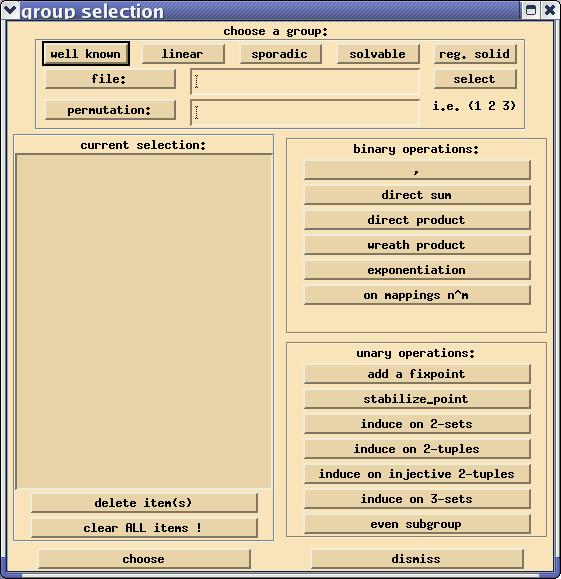
Let us describe now how to construct a group. Most impartant are the five buttons in the top row, labelled well known, linear, sporadic, solvable and reg. solid. Each of these opens another dialogue, where certain pre-defined permutation groups can be chosen. Consider the first one well known. After clicking on the button, the dialogue
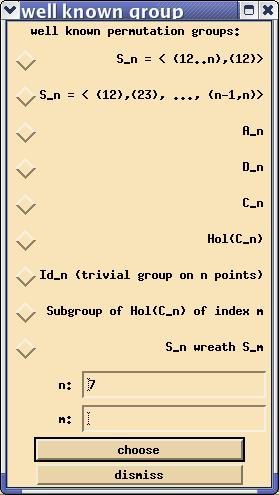
Let us go back to the group selection dialogue.
The next button entitled linear opens the dialogue

Back in group selection, the next button entitled sporadic opens the dialogue
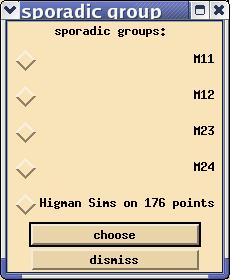
The fourth button in group selection, entitled solvable opens the dialogue
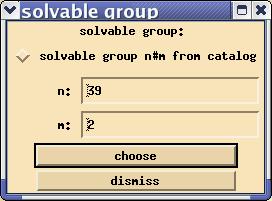
The last button in group selection, entitled reg. solid opens the dialogue

After choosing a group G by specifying a recipe in the group selection dialogue,
and after pressing the button choose and successfully constructing the group,
we will see the name of the group, the permutation degree, and the group order in
the three fields group, v and order in the DISCRETA main window.
From now on, G is fixed.
In case that we have chosen a symmetry group of an Euklidean object,
we may decide to actually see this object itself.
For this, we go into the Group menu again and choose show solid.
Another window opens up, displaying the object in 3D-space, for instance as

Any time you have defined a group, you may choose to investigate its subgroup lattice.
For this, go into the Group menu again and choose
calc subgroup lattice: w.r.t. inner automorphisms.
You may wish to invoke this funtion only for groups of moderate size (i.e. at most a few thousand elements),
since otherwise the computation becomes too time and memory intense.
Assume we still have the group of the Dodecahedron, which is isomorphic to A5.
Then coosing the button results in a small computation, which can be traced in the terminal window.
The final output looks like
{1,3,3,1,1} 9
{1,31,21,5,1} 59
computation of subgroup lattice finished.
The two rows of numbers correspond to the number of conjugacy classes of subgroups (first row)
and the number of subgroups (second row) in each layer of the subgroup lattice.
The layers are determined by the number of prime factors (including multiplicities),
dividing the order of a subgroup. the layers are listed in brackets,
going up from layer 0 (the trivial subgroup) to the highest layer (the group itself).
Afterwards, the total number is given.
In order to actually see the subgroup lattice, go into the Group menu again and choose show subgroup lattice, Burnside matrix. A latex document will be prepared and translated autopmatically. If you browse this document, you may find on the second page a graphical display of the subgroup lattice. In case of the group of the Dodecahedron, A5, we obtain:
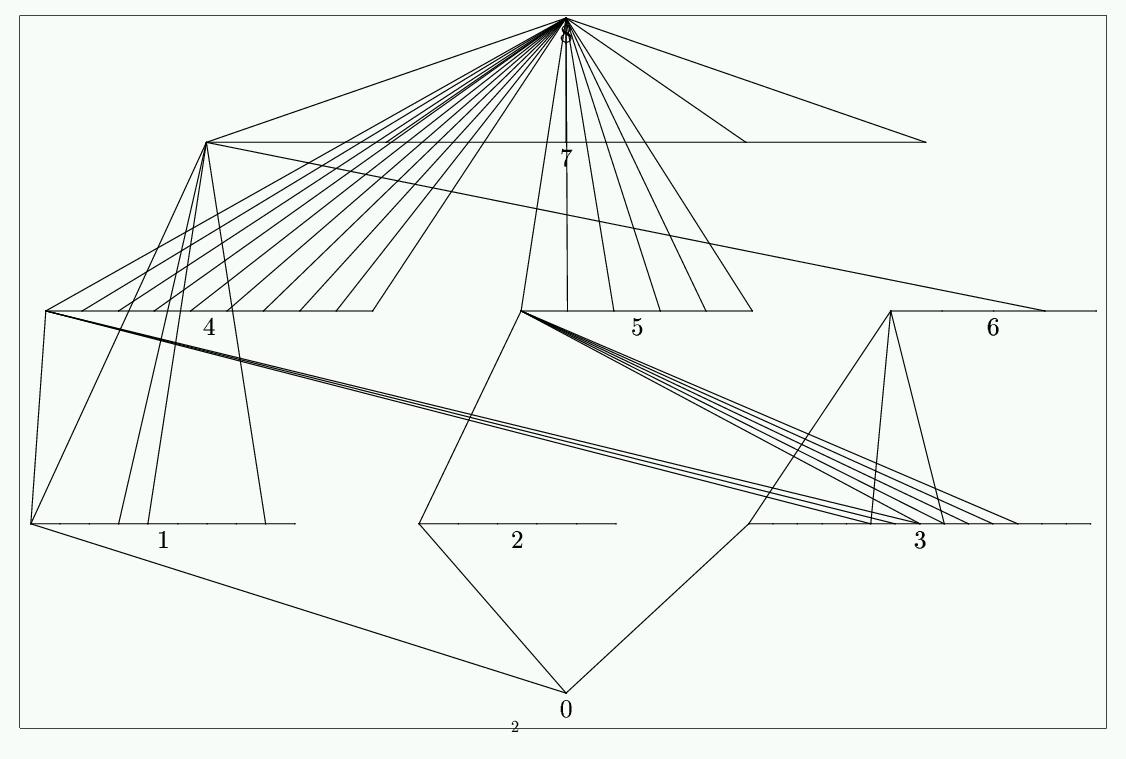
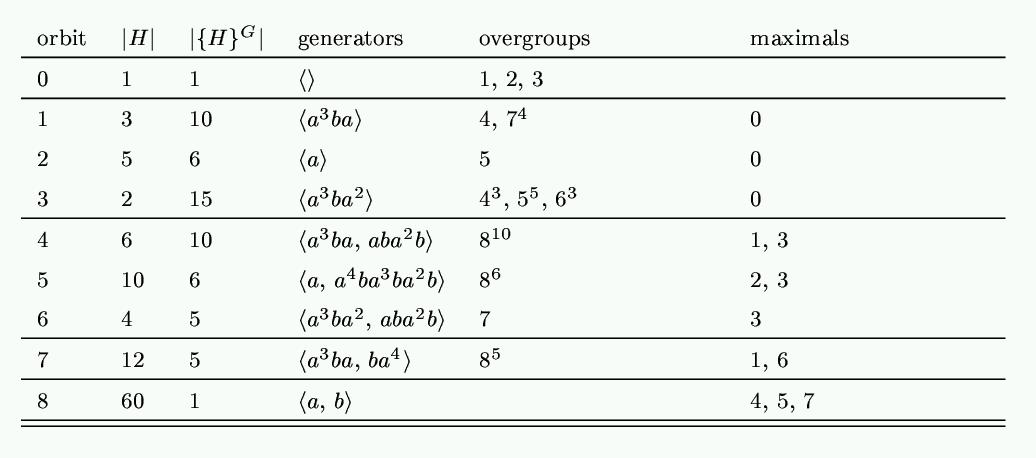
At the beginning of Step 1, we chose the design parameters t-(v,k,lambda). Indeed, the parameter v turned out to be the degree of the permutation group G we have chosen to prescribe. So far, the other three parameters did not come in, but this will change in a minute. In order to construct a design which is invariant under G we apply the method of Kramer and Mesner which allows to describe such designs as 0/1 solutions of certain integral systems of equations. The coefficient matrix of this system has already been introduced as the Kramer Mesner matrix. This matrix depends on G and on the parameters t and k, and hence we denote it as Mt,kG. The rows are indexed by the orbits of G on t-subsets, whereas the columns are indexed by the orbits of G on k-subsets (of 1,...d, of course). The matrix entry corresponding to a t-orbit TG and a k-orbit KG is the number of elements K' in the orbit KG which contain T. In order to compute Mt,kG, we first specify G, which we already did in Step 1. We now put in the values of t and k into the corresponding text fields in the main window. After that, we choose compute Kramer Mesner matrix from the Kramer-Mesner menu to actually compute the matrix Mt,kG. The actual computation produces some output in the text window. The orbits of G on sets of size at most k are computed by an induction on the size of the sets. In the end, a file is created containing all the data from the computation. The filename starts with "KM_", then comes the name of the group, and after that the values of t and k in the format t`value of t'_k`value of k'. The extension is ".txt". We call this the KM-file. Its name appears in the file text field in the main window. We may want top have a look into that file. For this, we choose show matrix in the Kramer-Mesner menu. We may have to scroll within the larg text field in the bottom half of the DISCRETA window, to find the actual contents of the file. We are now ready to construct the designs. We choose lambda and enter the value into the lambda text field. Then we choose LLL in the Solve menu. We get information about the existence or nonexistens of solutions in the terminal window. Note that DISCRETA always trues to compute the complete set of solutions, i.e. the number which is given (if the program terminates successfully) is the exact number of designs with that prescribed automorphism group. Note, however, that this does not give the number of isomorphism types of designs. That number is to be determined later. In order to be able to work with these solutions later on, we choose get solutions from solver in the Solver menu, which copies the solution vectors into the KM-file.
Example: Assume we want to construct designs invariant under PGGL(2,32). We go into the group selection dialog and from there into the dialog for linear groups. We fill in n = 2 and q = 32 and click on PGGL:

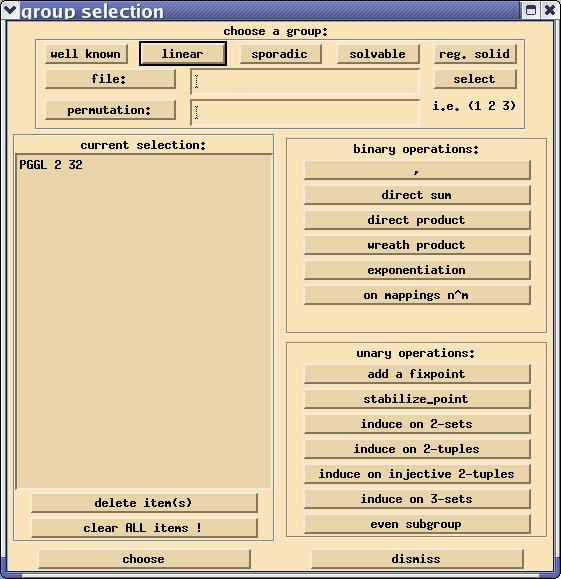



% m, n: 3 13 4 4 8 4 4 4 0 0 0 0 0 0 0 5 5 5 0 0 0 5 1 5 1 1 0 0 1 4 3 2 5 2 2 1 2 1 1 3 1We know choose lambda = 12 (If we don't know what to choose we can ask the lambda_i function in the Parameters menu. in this case, we get a value of Dl of 4, and after unsuccessfully trying 4 and 8, the next candidate is lambda = 12.) After that, we choose LLL in the Solve menu, which starts the actual solving process for designs. After a short while, we see some output in the terminal window. The output finishes by telling us about the number of solutions which could be found:
0010100110100 L = 12 0010101001100 L = 12 0010100011100 L = 12 0010101101000 L = 12 0010100111000 L = 12 Prune_cs: 103 Prune_only_zeros: 4 of 106 Prune_hoelder: 0 of 102 Prune_N: 1 Fincke-Pohst: 2 Loops: 265 Total number of solutions: 54 calling ... tail -10 lll.log >lll.log.1 finished !In this case we have 54 solutions, all of which are displayed as 0/1 vectors (we show only the last 5 of them here). We finally choose get solutions from solver in the Solver menu to copy the solution vectors into the KM-file.